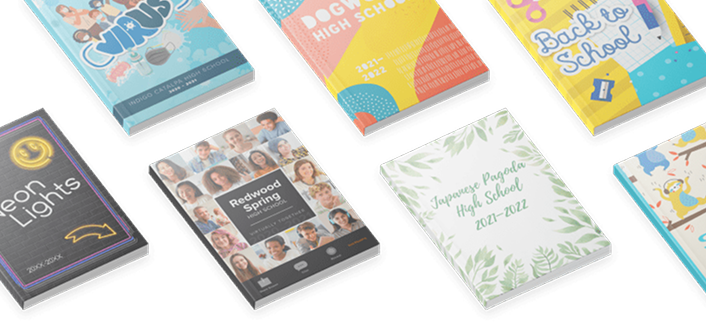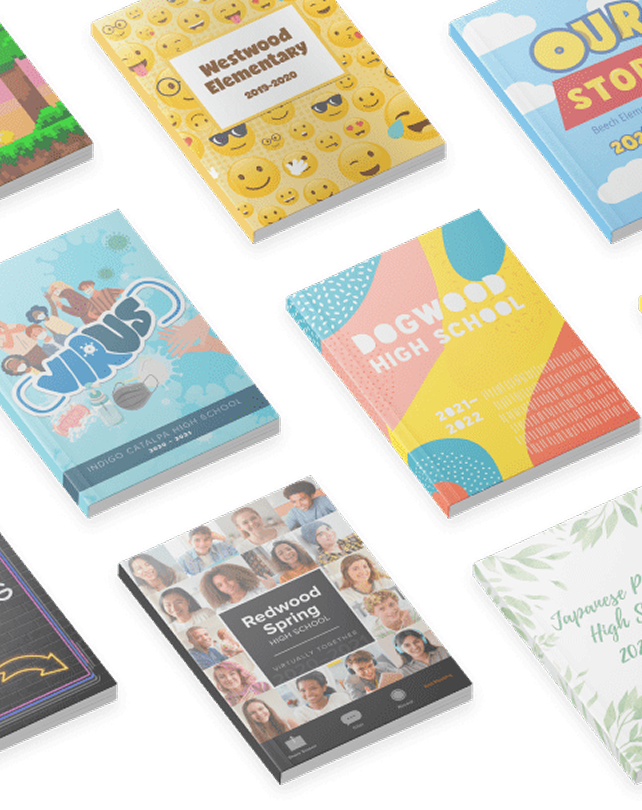Most popular
Subscribe to our blog
Most recent

Turning feedback into yearbook theme magic
People often ask about the process behind creating yearbook themes—how we come up with ideas, what inspires the designs, and what steps go into making them both creative and versatile. To help answer those questions, I’ve gathered the most common ones I hear, along with insights into how we approach theme development.
– Allison Vecchio, Design Director
– Ashlyn Wong, Associate Graphic Designer
Q: What’s the first step you take when creating a theme for a yearbook?
Allison: The very first step is listening. We start with focus groups, inviting editors and advisers to react to early design inspiration and share what excites them. That feedback becomes ourcompass—it points us toward where to explore next. From there, the design team dives into inspiration.

Q: Where do you look for inspiration?
Allison: Inspiration comes from anywhere and everywhere—online platforms like Pinterest and Designspiration, opening credits in films and series, the type treatments on city signage, or the latest work from leading agencies like Pentagram. We also keep a close eye on current graphic design trends. Those pieces come together in a mood board, much like a collection of magazine tears, so we can see the direction starting to take shape. We cast a wide net at first, then refine and narrow down as we go.
One of the biggest themes actually came directly from our users during a focus group. The Gallery theme idea originated in a focus group session where a few customers described looking through a yearbook as feeling like walking through a gallery.

And, the idea for Gallery was born!

My most recent spark came during a trip to Madrid, where I visited the Museo del Prado, and the Museo Reina Sofía. My creative mind expanded tenfold viewing works by the old masters whom I studied years ago, such as Caravaggio, El Greco, Fra Angelico, and Heironymus Bosch.
Q: How do you decide what to design?
Allison: Our process is customer-focused and data-driven. After running focus groups, we analyze the usage data in our application to see which themes are trending across schools. We combine that with customer feedback to understand why something resonates. Once we have that insight, the design team begins exploring themes that can work across different grade levels and schools.
Many questions come into play when we think about what to design. Does the theme make sense for all genders? Will it look too feminine, or too masculine? How can we achieve a healthy balance? Is this primarily for an elementary school, or could it be designed in a manner to apply to all grade levels?
Q: How do you choose your color palette and typography to match the theme?
Ashlyn: Color and typography decisions always begin with exploration and testing. We build out several palette and type combinations, then test them — dropping them into sample spreads, pairing them with backgrounds, and checking legibility. We look at how bold or neutral tones interact with student photography, and we make adjustments based on feedback from internal collaboration. It’s a cycle of experimenting, testing, and refining until the theme feels balanced and cohesive.


Q: How do you create the artwork?
Allison: In our focus groups, customers told us they wanted the same collection of graphics across every theme. We set out to do this by working with illustrators to create bespoke artwork. Finding the right illustrator takes time. We review portfolios until we find one whose aesthetic aligns with the concept. For example, with the Gallery theme, we partnered with illustrator Ekaterina, whose warm, approachable style was a perfect fit. She created more than 100 illustrations that together gave the theme the feeling of walking through a gallery.

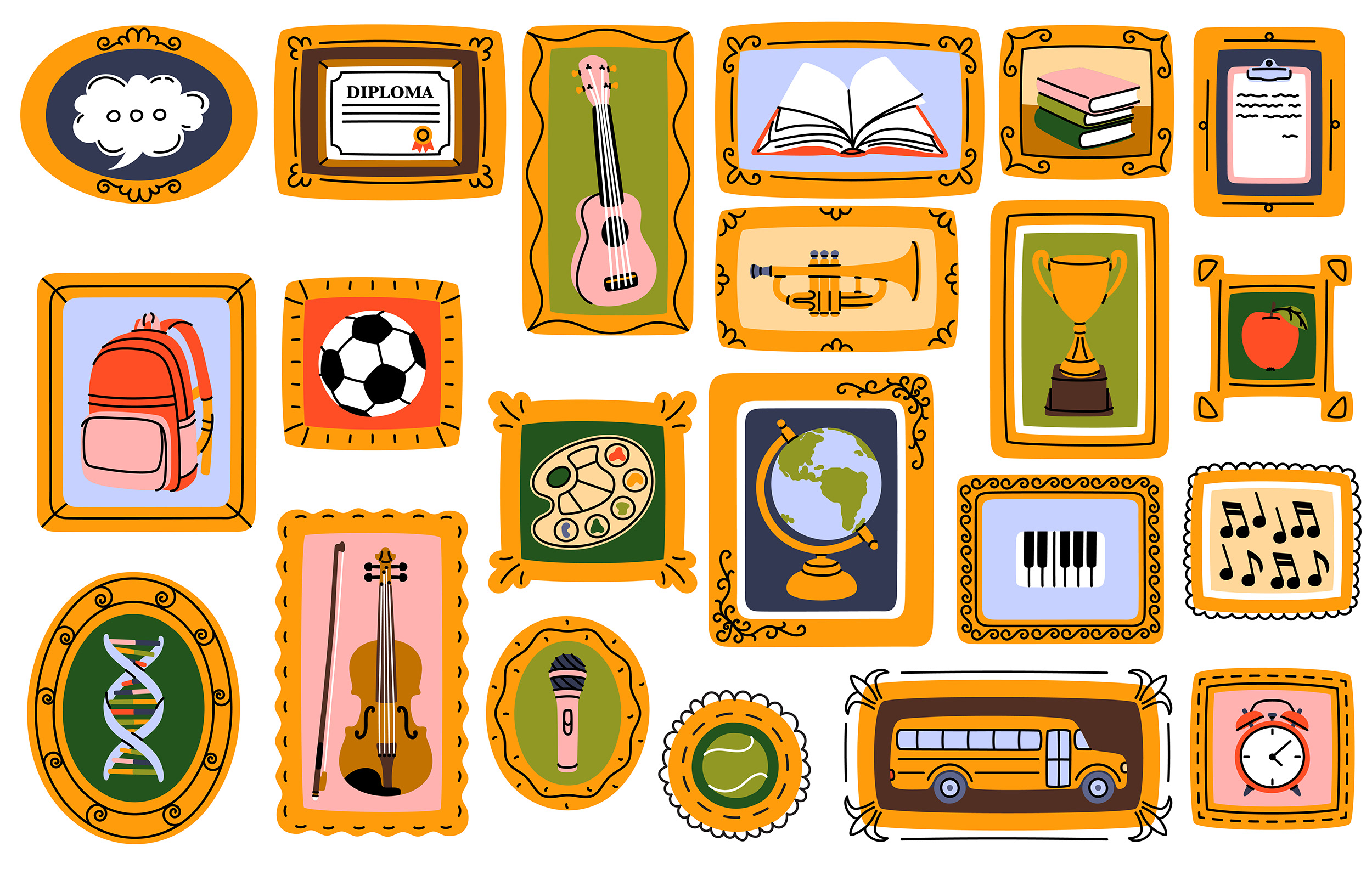
Q: Which past theme are you most proud of and why?
Ashlyn: The focus groups revealed that records and decades were popular, and we really wanted to give our users a full, cohesive theme that could synthesize these concepts. For the Record stands out because it challenged us to unify five distinct decades into one cohesive theme. Although we hit roadblocks and had to pivot several times, the final product was something fun, flexible, and unique. I’m proud of the way our team was able to not only fulfill our customers’ requests despite challenges, but problem-solve to create something revolutionary.
Allison: The themes that stand out most for me are the ones I see schools using again and again. Dream Big is one that always gives me the feels. It carries the charm of a children’s book, with richly illustrative backgrounds I created in Photoshop. Small details—a child holding a kite or soaring into the sky—symbolize limitless potential, inspiring students with the idea that they can achieve anything they set their minds to.
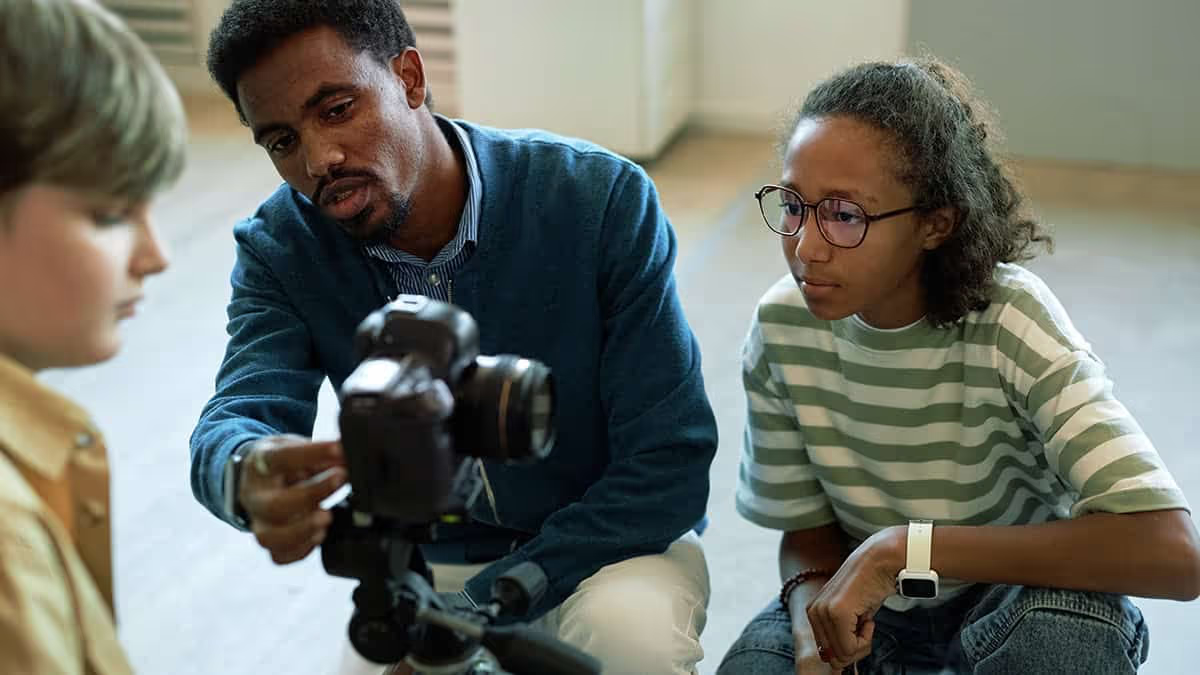
Cell phone ban: how are we getting photos?
With nearly half of US states banning cell phones in the classroom, many advisers reached out for creative solutions for collecting yearbook photos. Student cell phones can have cameras that capture photos as well as or better than traditional cameras, and have become a cost-reducing factor for yearbook teams. As more schools create and tighten policies governing cell phone usage on campus, we need practical solutions for yearbook class.
The yearbook’s mission remains unchanged.
Take heart, yearbook creators, when parent volunteers weren’t permitted on campus, we pivoted. This is no different. [FWIW, I’m imagining being on a horse, like William Wallace, as I type this.]
The quick response
The easy solution is to grab some point-and-shoot cameras for yearbook students to have on hand or a few iPad Pros, if your school permits it. Focus the first few class or club meetings on the basics of composition.
Another solution is photo training with a DSLR or mirrorless camera. Explore aperture (depth of field) and keep track of what ISO and white balance work for specific locations on campus, like the dreaded gym pics, which always look straight out of the 1970s with the yellowed floors and fluorescent lights.
If you don’t have budget constraints, check out our recommendations for yearbook gear.
Capital expenses aren’t for every yearbook team. Additionally, neither of these solutions addresses how to get you and your team everywhere—you can’t. Adding avenues for school staff, parents, and students to contribute photos will grow your reach.
Create a submission pipeline
Photo drop campaigns should be part of every post-event communication from your yearbook team. Did fourth grade take a field trip to the zoo? Reach out later that day to the parents and teachers who went for their snaps.
Keep in mind, the easier it is to share, the more results you will receive. Also, limiting yourself to one or two avenues will simplify your back-end organization.
Yes, this approach might require more planning and follow-up than in past years. Remember, the systems you build now will benefit your yearbook program long after the initial challenges are resolved.
Photos from Teachers and Staff
While we cringe at asking our classroom champions to do one more thing, the thought of not celebrating their outstanding work is far worse. Work with your campus administration to add Google folders to the school’s shared Drive.

There should be a folder for each teacher and school-wide folders for holidays, recess, specific school events, lunchtime fun, assemblies, etc.
Photos from Parents
Many of the advisers in Treering’s Official Facebook Group say they have room parents responsible for in-class photos. Additionally, parents are often present at outside events such as concerts, field trips, and games. Partner with them for photos of
- Off-campus event and athletics photos
- Candids from carpool, pick up/drop off
- First day
- Any dress-up or spirit day
- Summer and winter vacations
- Homework and student art
In addition to a shared folder to which parents can drop images, share an email address.
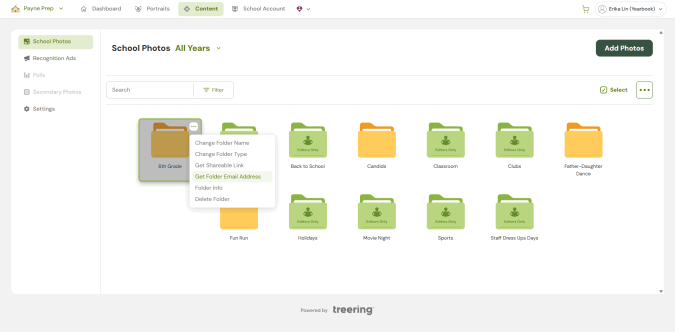
You can even send targeted asks after events: Hey Fatima, It was great to see you at the Science Fair. Would you please send me 2-3 photos of Jackson and his friends so I can include them in the yearbook? Thank you!
Full disclosure, any time I see parents taking photos of their children, I ask them to email those photos to me on the spot.
Shameless.
Photos from Students
If your yearbook program has a class or club component, creating photo assignments is one way to secure photos from students. The last thing you want to do is just tell a student, “Go take photographs of science.”
Many schools employ a beat system, assigning students to specific grades, clubs, and sports. This is a way to monitor coverage while teaching communication and project management. Students connect weekly with their contacts (coaches, teachers), find out what is happening, and take photographs of events.
The beat system also serves as accountability: if Erika’s beats have empty content folders in week three, the editorial team needs to redirect her efforts.
If you need help providing photo support, explore
The key to success lies in early, frequent, and clear communication with your entire school community. When staff, parents, and students understand the goal and their role in achieving it, collaboration becomes smoother and more sustainable.
Explain why the cell phone ban affects yearbook coverage, what kinds of support you need, and how you’ll collect photos. Then, keep the conversation going:
- Remind teachers of upcoming photo ops
- Update parents with specific photo requests
- Train students to use alternative tools and plan ahead.
The more proactive you are, the fewer last-minute gaps you'll face.

Why you need evergreen content for yearbook
Like its namesake, evergreen content stays fresh for a long time, unlike the tie-dye loungewear we are still trying to forget. While you should definitely include polls and trends in your yearbook (it is the story of the year after all), open-ended interview questions (such as the 40+ we are giving you below) should remain in your repertoire for three reasons:
For ease of use, we organized these interview questions by yearbook section. Grab your editorial team and create your list!
Student Life
Because some of your formative moments occur outside the classroom, be sure to include all that goes into the school day.
Campus Life
Routine
People
These questions make great sidebars to go along your portrait pages.
Milestones
Interests
Academics
Athletics
Bonus: Trending Topics
Add content on the following to complement the evergreen content in your yearbook.
For even more interviewing tips, check out the yearbook storytelling module from Treering's free curriculum.

3 content ideas for portrait pages
When “outsiders” think of yearbooks, they imagine little beyond the portrait pages. They see the obligatory blue background and big grins that accompany a moment in time many of us, as students, dreaded. (C’mon, we all didn’t receive the Glamor Shots by Deb experience!) Since this is a part of students’ permanent record, it's a necessary component. It is a part of the historical record of the school year. It’s also not our students’ favorite. Long ago, this adviser decided to decrease the size of yearbook portraits, while increasing specialized content. Here are three ideas to break up your portrait pages by adding rich, personal content.
1. By the Numbers
Use stats and surveys to provide a quantifiable portrait of the students pictured on your pages. Begin by understanding what is important to your students and then ask questions. For example, if your school’s focus is on health and wellness, break down how students and staff contribute to that goal by including content such as
Pair the numbers with photographs of students engaging in the activities and quotes for an even more personal approach. What does it mean to be a part of a community so encouraging of physical activity? How do students balance their school work with tournaments and performances?

2. Keep Content Class-y
Grade spreads in your portrait section are ideal for academics or class-specific coverage. Highlight the unifying aspects of school life, such as class trips or advisory periods, and then ask students about their individual experiences with each. Grade sections could also include:
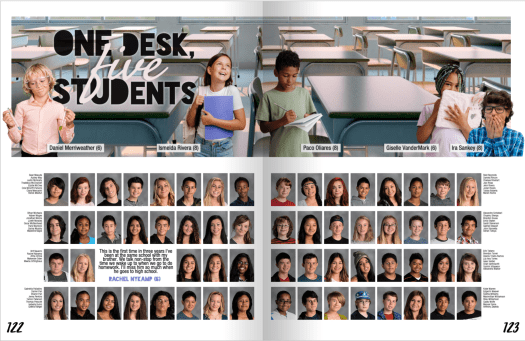
3. Get Personal with Portraits
Personality profiles and student life modules both create opportunities for an inclusive yearbook by targeting lesser known students or students with interests outside school-sponsored arts and athletics. These content modules add voices to the portrait section of your yearbook!

Take advantage of the additional space you'll create by shrinking portraits to pull out more content from your student body.
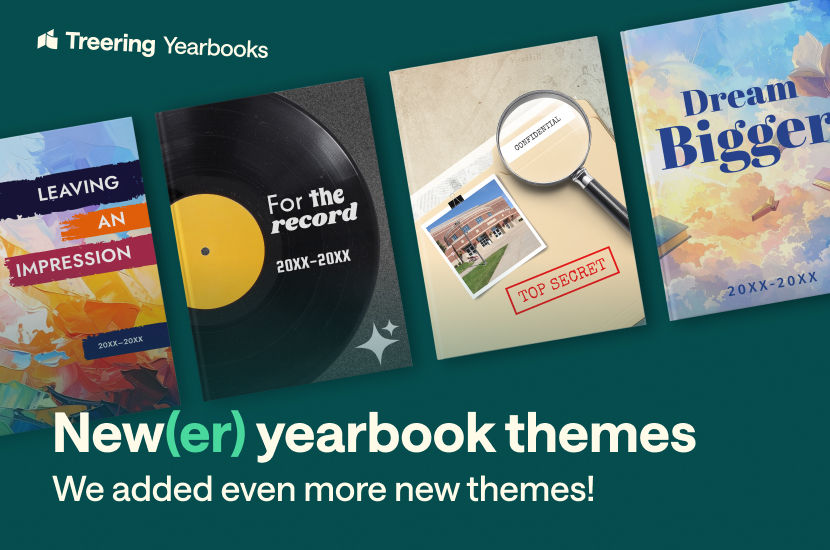
4 Storytelling yearbook themes
A yearbook theme isn’t just layout, graphics, fonts, and a color palette. It’s about storytelling. A developed theme goes beyond the visual, guides your coverage decisions, and sets the tone for the book.
Treering’s design team listened to many schools’ stories during their spring focus groups. The first wave of themes reflected the visual package most schools wanted. This second one expands to add the verbal.

For the Record
Exploring decades from the 1950s to the 1990s, “For the Record” taps into nostalgia. With a two-page style guide of decade-specific graphics, colors, and fonts, yearbook teams can create their own “greatest hits” of the school year.
Adding storytelling elements such as student-created playlists or superlatives presented as album covers will make your memories feel like an anthology.
Additionally, the focus groups of middle and high school advisers asked for less busy backgrounds and more texture. Usually, people would balk at "just" two backgrounds. However, having these consistent threads is why each section works as part of the whole.
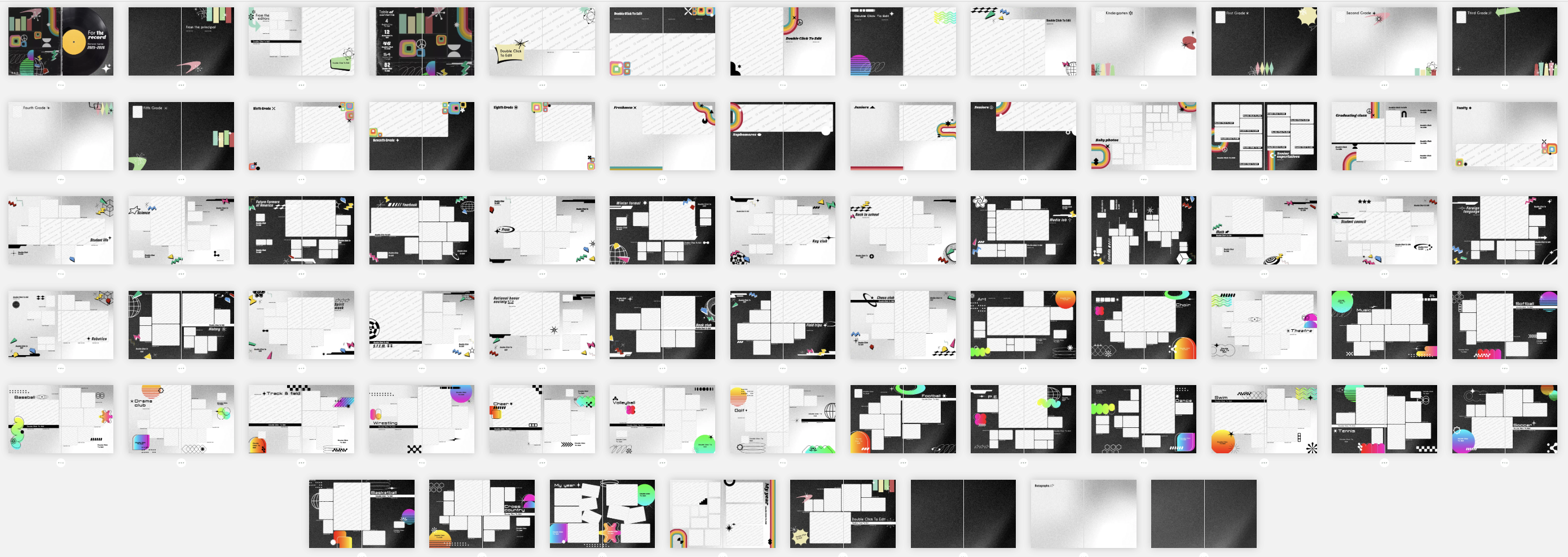
Focus group participants also wanted layouts that emphasized hierarchy and had room for captions and copy. The design team gave yearbook teams this plus flexible options within this theme. They can
- Differentiate sections of the book by decades
- Use one decade to create their own throwback look

Top Secret
The declassified look at the school year is one of the most powerful storytelling mechanisms:
- Showcase hidden gems on campus
- Use photographic clues on divider pages to make small things part of something bigger
- Deconstruct campus happenings with “mission report” sidebars
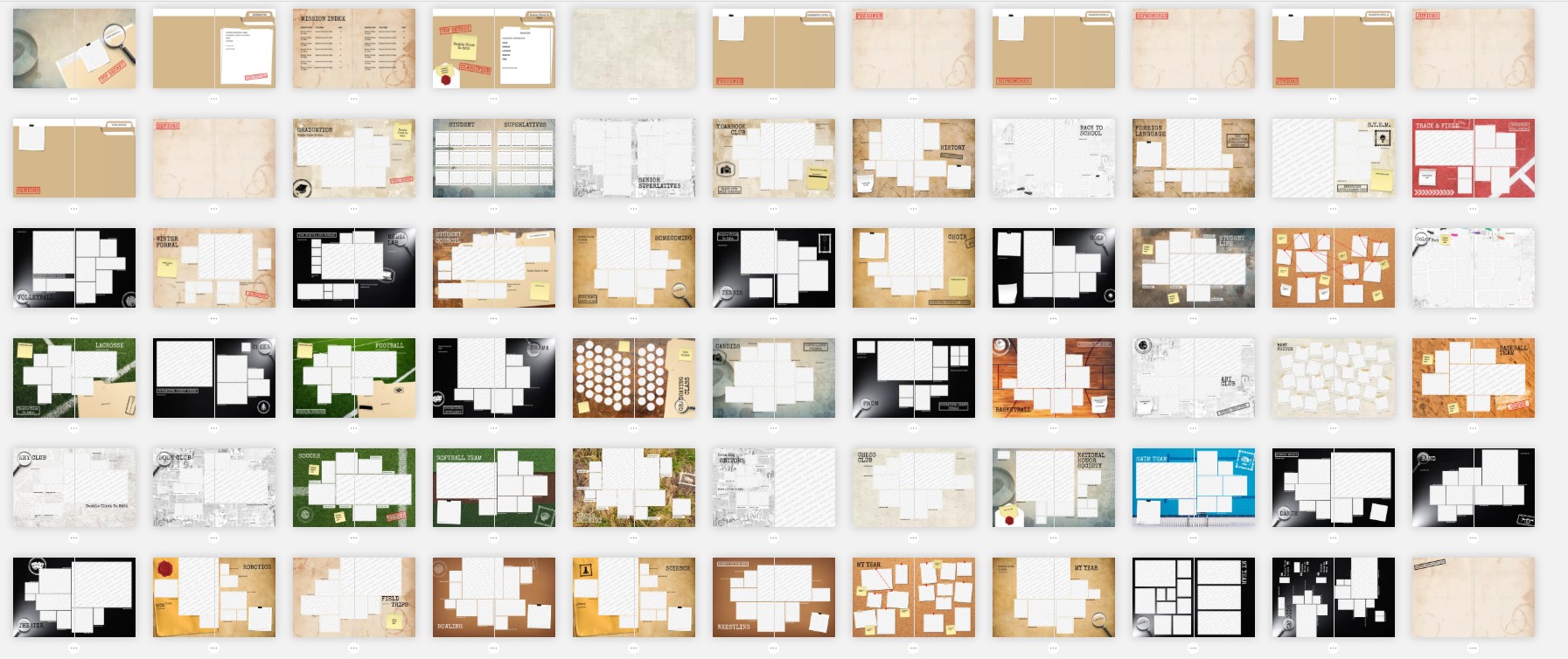
This theme builds on collage-style design elements—stamps, photo frames, textured backgrounds—but updates the look with a contemporary aesthetic. It draws from the mission vibe while keeping the layouts approachable and fun. And it works for any level of school:
- Elementary school: use playful stamps, oversized labels, and bright textures to highlight classroom memories and fun facts
- Middle school: lean into detective-style layouts such as “case file” spreads on clubs and activities
- High school: take a sleeker approach with dark backgrounds, sharp typography, and subtle textures that nod to spy dossiers without feeling gimmicky
Students will feel like they are all in on the secret together.
(Yes, this theme inspired our team: we applied some of the elements to National School Yearbook Week 2025’s programming.)
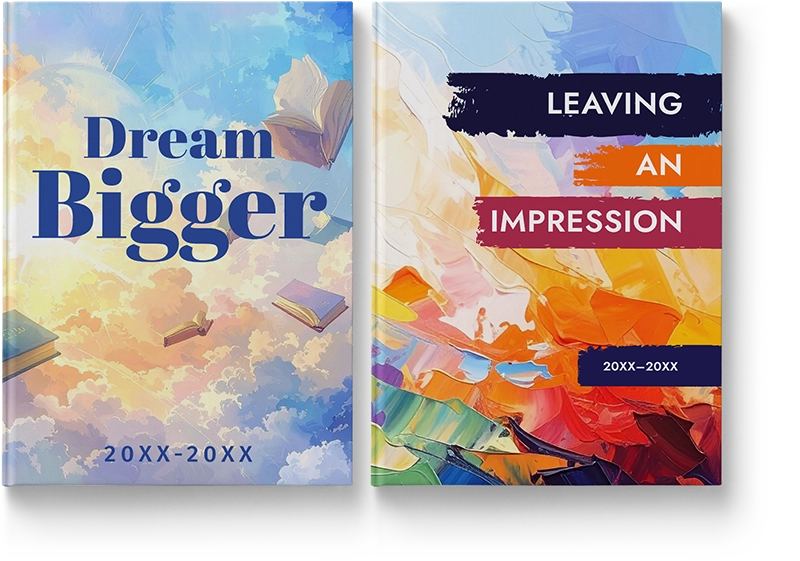
Dream Bigger and Leaving an Impression
Another focus group finding is the appeal of art styles as visual themes. The design team introduced “Gallery” in the first wave, followed by two artistic takes, “Dream Bigger” and “Leaving an Impression.”
The powers that be at Pantone called out neutrals and soft naturals for the Color of the Year 2025. The “Dream Bigger” theme leans into this popularity, offering soft washes of color and flowing shapes that stand in contrast to the textured, thicker brushstrokes of Impressionist paint used in “Leaving an Impression.”

Whereas “Dream Bigger” is ethereal and reflective, “Leaving an Impression” is bold and dynamic. It’s a theme designed with flexibility in mind, especially for K-12 schools.
For younger grades, it offers high-collage layouts that make it easy to include as many students as possible while keeping the design polished. For upper grades, it supports modular design, which means layouts can be broken into smaller, contained units of coverage. With modular design, every spread can tell multiple stories at once, building a richer picture of school life.

Both of these artistic themes make the perfect canvas for seeing how this year is part of a larger journey.
Student stories and voices matter. Your yearbook theme should provide a lens through which your readers can examine them. Treering can help with a collection of over 200 pre-designed themes.
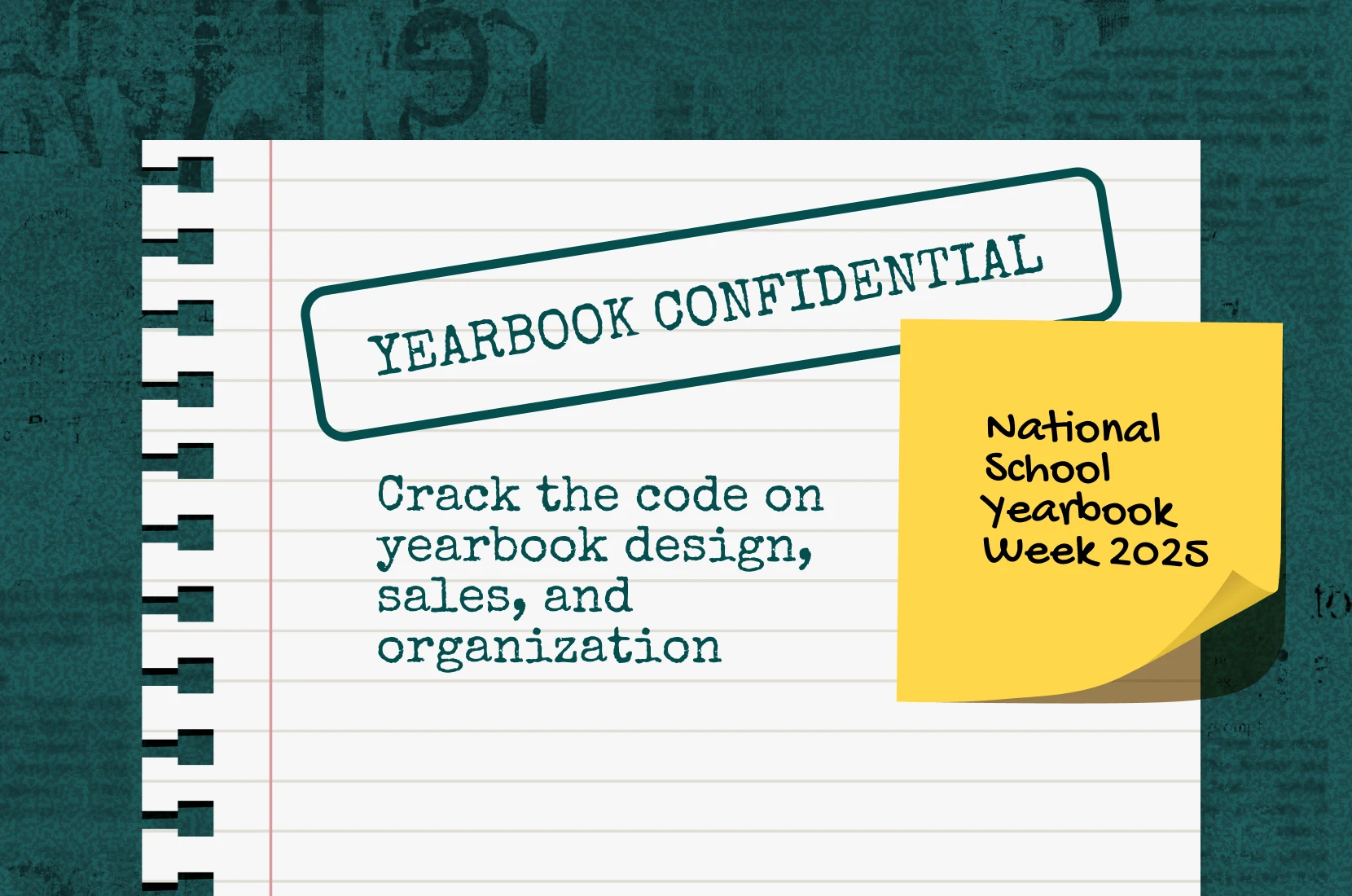
National School Yearbook Week 2025: ideas to celebrate
With Proclamation 5703, former President Ronald Reagan made yearbooks even more celebration-worthy by setting apart the first week of October for “appropriate ceremonies and activities” to recognize the creators and the power of a yearbook program. Treering intends to do just that during National School Yearbook Week, October 6-10, 2025.
Yearbook Confidential: your briefing
Yearbook creators will have declassified access to live training, photo contests, and giveaways. (If you’re super in love with the vibe, check out the Top Secret theme that just dropped for your yearbook.)
Yearbook contests
There are six ways to win: one week-long yearbook Bingo game and five daily Facebook giveaways.
Monday, October 6
Bingo begins. Download your unique bingo card and play along. We’ll “call” words via Meta stories (see them on Facebook and Instagram). The first verified Bingo winner will receive a Canon EOS Rebel T7 DSLR camera with an 18-55mm lens. Get the full Bingo rules here.
Additionally, yearbook creators can share their favorite fall photo to our “Operation Autumn Aesthetic” Facebook photo contest. The strongest storytelling photo will win a $50 gift card.
Tuesday, October 7
Share your insider ideas for photo organization on our daily Facebook giveaway post. HQ (aka Treering’s marketing department) will reward one adviser at random with a $50 gift card.
Meta stories for our week-long Bingo game will continue.
Wednesday, October 8
Another $50 gift card is up for grabs. We want to see your yearbook squad. The most creative team photo wins the daily Facebook post challenge.
If a verified Bingo winner has not come forward, we will increase the calls.
Thursday, October 9
Share your yearbook space, class, or desk on our daily Facebook post for the chance to win. The type-A, TikTok-inspired, and completely unhinged–we want to see them all.
Friday, October 10
Close National School Yearbook Week 2025 with your best sales tips or ideas for a chance to score a $50 gift card on our Facebook post.
Live training
Treering Live (TRL) is Treering’s flagship event. During National School Yearbook Week, TRL will have all the design training, coveted prizes, and organization inspiration that yearbook advisers have come to expect.
What to expect at Treering Live: not-so-top-secret training
With your free registration, Treering Live: Yearbook Confidential features 19 sessions over two days. The programming spans from adviser basics to an interactive photography session. Your mission, should you choose to accept it, is to join HQ for intel, ideas, and a little undercover fun.
The schedule, like Treering, is fully customizable.
Tuesday Sessions
1:00 pm PT: Opening session
1:10 pm PT: Session 1 - choose one session to attend
- Top 10 questions new advisers ask
- Yearbook design trends
- Teaching yearbook: curriculum overview
1:50 pm PT: Session 2 - choose one breakout session to attend
- Live demo: portraits
- Adviser roundtable
2:30 pm PT: Session 3 - choose one breakout session to attend
- Photo tips
- Live demo: yearbook style guides
- Getting more students in the book
3:10 pm PT: Session 4 - choose one breakout session to attend
- Anatomy of a yearbook
- Teaching yearbook: theme
3:45 pm PT: Closing session
Wednesday Sessions
1:00 pm PT: Opening session
1:10 pm PT: Session 1 - choose one breakout session to attend
- Building your team: yearbook jobs and recruitment
- Treering design tools
- Photo journalism (interactive session)
1:50 pm PT: Session 2 - choose one breakout session to attend
- Yearbook mistakes to avoid
- Live demo: upgrading portrait pages
2:30 pm PT: Session 3 - choose one breakout session to attend
- Top 10 questions parents ask
- Live demo: from good to great
3:10 pm PT: Session 4 - choose one breakout session to attend
- Live demo: page templates
- Teaching yearbook: writing
3:45 pm PT: Closing session
All sessions will be available on the Yearbook Club Replay, so you can re-watch those a-ha moments and catch any sessions you missed through May 2026.
Mission parameters: Bingo rules and FAQs
The National School Yearbook Week 2025 Bingo winner must be 18 or older and a Primary Chief Editor or Chief Editor at a US Treering school for the 2025-2026 school year. No purchase is necessary to participate.
By participating, you approve Treering to use your name, write-up, and school name for any marketing purposes, including but not limited to treering.com, social media, and mass media.
1. How do I get my Bingo card?
On Monday, October 6, each player will receive an email to download a card. Each one is a unique card with a number. Save your card—you’ll need it to claim a win.
2. How will clues be called?
A third-party Bingo randomizer will randomly select words, which will be announced via Meta stories (Facebook and Instagram) and in the Zoom Events lobby during Treering Live.
3. How do I mark my card?
Print your card or track digitally. Mark off words as they are called.
4. What counts as a Bingo?
We are playing classic Bingo: a straight line of five words (horizontal, vertical, or diagonal).
5. How do I claim a win?
Email marketing@treering.com immediately with your name, Treering school, and card number. The first valid email received is the winner.
6. What happens after I email my win?
We’ll verify your card against our called words. The first valid email received is the winner.
7. Can more than one person win?
No, only the first verified winner counts.
8. What if I lose my card?
No problem, just download your card again. You may have missed some words; jump on our socials to get caught up.
9. How many rounds will we play?
There will be one round of Bingo from October 6-10, 2025.
10. What are the prizes?
The winner will receive a Canon EOS Rebel T7 DSLR camera with an 18-55mm lens. Treering will ship the camera directly to the school address associated with the winner’s Treering account.
11. Do I have to shout, “Bingo?”
We aren’t going to stand in your way if you want to do the Bingo Boogie. Just remember to be the first to send an email marketing@treering.com with your name, Treering school, and card number to claim the prize.
12. Can I play if I join late?
Yes! All of the words announced via Meta stories will remain for 24 hours. You’ll just start marking from the current clue onward.
13. I’m a content creator. How can I share what I’m doing for National School Yearbook Week on social media?
Tag Treering Yearbooks (@treering on Facebook, @treeringcorp on Instagram and TikTok) and use the hashtags #NationalSchoolYearbookWeek, #NationalYearbookWeek, #YearbookWeek, #YearbookBingo
Social Contest Rules
The National School Yearbook Week 2025 photo contest winners must be 18 or older and a member of a Treering school for the 2025-2026 school year. No purchase is necessary to participate.
Valid posts must include an original photo. No AI images allowed. By participating, you have verified the approval of others pictured, and you approve Treering to use your name, write-up, and school name for any marketing purposes, including but not limited to showcasing on www.treering.com, sharing on social media, and sharing with media.
The photo criteria will be based on its creativity, relevant emotional impact (humor is more than acceptable), and overall aesthetic appeal.
If you have any questions, contact us at marketing@treering.com.
Nearly 30 years later, National School Yearbook Week remains a time to reminisce and a time to look forward, hopefully with a few wins for you and your yearbook program.

Creating a yearbook style guide
Ever flip through a yearbook and feel like every page was designed by a different person? (Spoiler alert: it probably was.) That’s what happens without a style guide. A yearbook style guide is your rulebook for keeping fonts, colors, and writing consistent so your book feels polished instead of patchwork. It sounds like a design hack, and in reality a yearbok style guide safeguards your theme's brand. Once it’s in place, your yearbook team can stop trying to remember what point the headline font is and get back to creating great coverage.
Wait, what is a yearbook style guide?
Think of it as a playbook and your staff training manual. Your style guide covers two big things:
- Visual theme: fonts, colors, and graphic
- Verbal theme: tone, voice, how you list names and grades
With those basics locked down, your team won’t waste time asking, “Do captions need periods?” or “Which blue are we using again?"
This guide, encompassing design and writing, ensures a unified style while serving as a coaching tool for your team during the layout and design process. Beyond that, it acts as a visionary tool, allowing early development of a creative direction for your book. By providing clear instructions on elements like fonts and colors, the style guide liberates your team to focus on what truly matters, developing coverage ideas, capturing compelling photos and quotes, and crafting stellar layouts. Again, it’s the key to eliminating distractions and letting creativity flourish.
Design: the visual part of your style guide
Often called the visual component of a yearbook theme, design is what people see. Here’s where yearbooks most often go off the rails:
- Fonts
- Color palette
If you’re going to do that, though, you need to cover all your bases and not leave room for interpretation. To do that, focus on locking down font choices, color choices, and how specific aspects of your layouts should look (like whether all photos need captions and, if you have a caption, what that looks like).
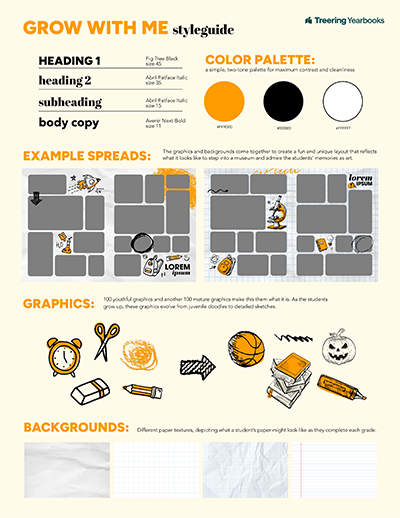
Choosing a Font Palette
With hundreds of fonts from which to choose, resist the temptation to use more than three. Everyone has a preference (#TeamGaramond). Here’s the thing, though. Constantly changing them impacts your readers’ ability to comprehend what’s happening, according to science. Yearbook fonts should complement each other.
When you pick them, define their use:
- Headings and subheadings
- Body copy and captions
- Accents, such as folios, pull quotes
Choosing a Color Palette
Focusing on readability is the first step to choosing font colors. The secondary objective will be using color to enchance the mood of your theme.
If that feels intimidating, using one of Treering’s 300+ themes gives you access to a proven color palette.
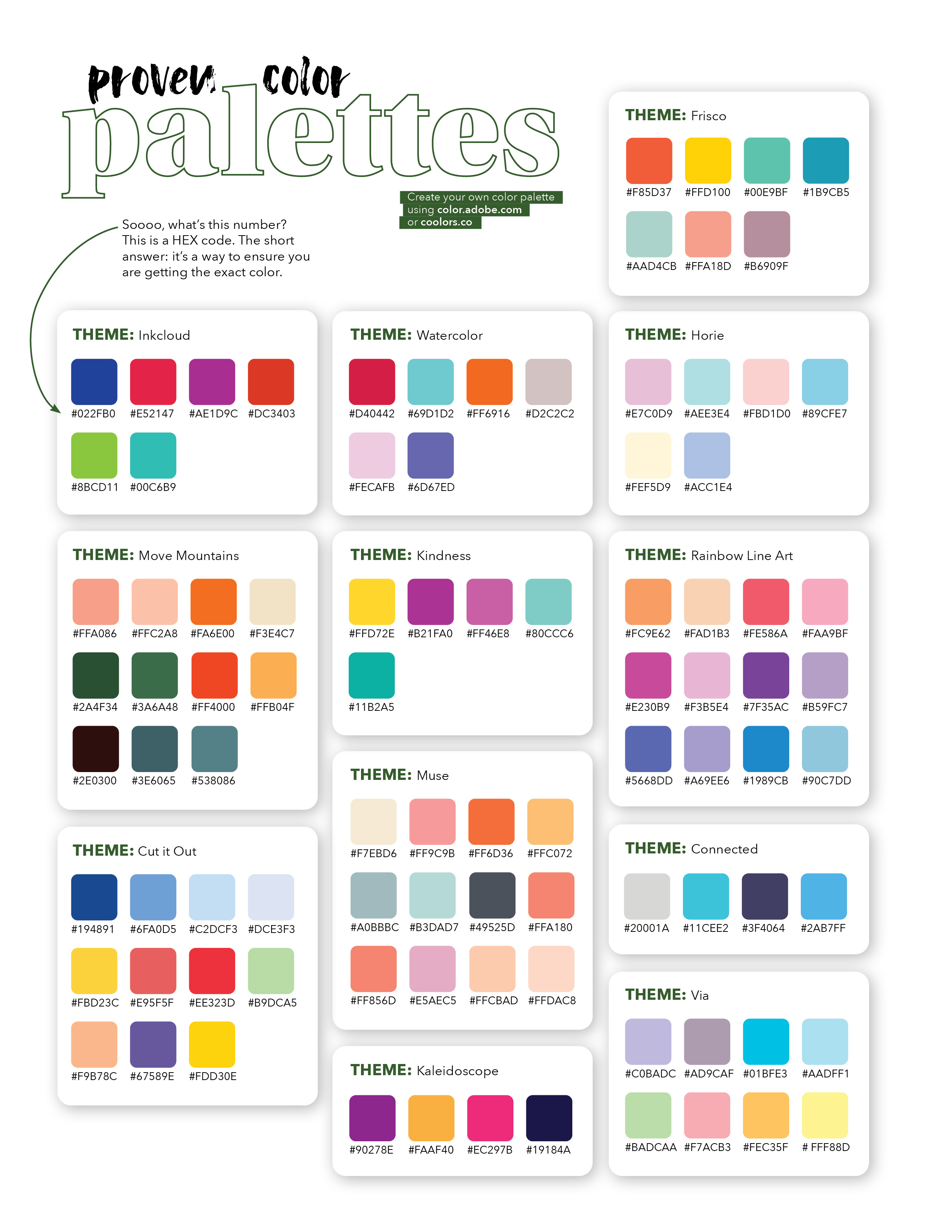
Verbal: the second part of your style guide
Design isn’t the only place things can get messy. Writing needs consistency too. Otherwise, your book will feel disjointed from page to page, like an awkward game of telephone. A few simple rules in your style guide will prevent that.
News sources, including yearbooks, use The AP Stylebook to govern writing mehcanics. Instead of investing excessive hours in an in-house style guide creation, we recommend leveraging the comprehensive AP Stylebook with minimal adjustments for your yearbook.
Instead, focus on tone, voice, using a simple outline. Ensure consistency by reviewing each section of copy against your agreed-upon style.
Tone
How should your yearbook sound? Fun and playful? Serious and academic? Pick one overall mood so your coverage feels intentional.
Voice
Think of voice as personality. Will your headlines be straightforward, such as "Basketball" or a little casual with some humor sprinkled in? Choose a lane and stay there.
Names and grades
Standardize how you list students’ grade levels. For example: Jordan Smith (11), Jordan Smith ’28, or Jordan Smith, a junior. Pick one format and apply it everywhere. These small choices add up to a polished, professional read.
Slang
Be careful here. What feels trendy now might be confusing in a few years, or even alienating to som students reading today. Stick to everyday language unless it’s universally understood.
Spending a few days on your style guide might not feel as exciting as brainstorming cover art or getting set up for photographing the Homecoming Court, but it’s the move that makes everything else easier. A solid style guide locks in your theme, keeps every page visually and verbally connected, and saves your team from endless “which font?” debates. Put in the effort up front, and you’ll walk away with a stronger theme, smoother workflow, and a yearbook that feels intentional from cover to close.

Teaching yearbook: 11 resources to bookmark
We created a master list for practical, tested strategies that work in a real yearbook classroom. If you didn’t volunteer to take on yearbook class (we are few, but mighty), you either showed up late to the meeting, or you’re a new teacher. Then what? Traditional teacher prep programs trained us for classroom management and subject-specific pedagogy. Teaching yearbook is a hybrid of design, photography, marketing, and event planning. It’s a prep that requires skills from multiple careers, and most of us learn them as we go, under deadline pressure, and with a room full of students watching. Major aura points loading.
Professional development resources
A stronger you means a stronger program. Here are some resources to help you take a recess from yearbook stress.
Webinars
Tuesday “Lunch and Learn” sessions are twenty minutes of focus to equip you and your team throughout the year. Just pick your time zone, log in, and leave with something you can use today.
Thursday sessions are one-hour overviews to help you plan, design, and publish with purpose. These synchronous training series start with the same line, “Hi, we’re Cassie and Erika, and we are here to join your yearbook team.”
They mean it.
Dealing with complaints
Two customer care experts, Treering’s Abby Oxendine and Chris Frost, a former Disney guest services agent, shared their proactive approach to working with teachers, parents, and students with yearbook complaints.
- Listen to the complaint
- Ask for specific details
- Offer a solution
- Follow up, follow up, follow up
Adviser burnout
We’d rather you have this one and not need it.
Some preventative burnout measures include workflow adjustments, such as
- Reusing layouts from previous years as templates
- Creating repeatable workflows, such as setting up photo and text styles
- Taking advantage of built-in design automations, such as portrait autoflow
If you’re already there and need a yearbook mindshift, build gratitude and celebration into your program… then call your publisher!
Planning resources for yearbook
Start the year with a clear plan so you run the yearbook, not the other way around.
Job descriptions
Clear expectations help guide student and volunteer yearbook teams. When the proverbial ball gets dropped, it’s easy to point the finger; being proactive with your yearbook team early in the school year will improve your workflow. It will develop ownership. It will reveal leaders.
Staff manual template
Another way to develop proactive communication is through a staff manual. A yearbook staff manual outlines policies and procedures for class time and crisis time. It includes how you will handle:
- Confidentiality
- Photos
- Superlatives and senior quotes
- Journalistic integrity
- Grading
- Style guide
- Content approval
- Equipment
- Complaints and refunds
Agenda slides for yearbook class
Agenda slides provide accountability for your yearbook team. They can be project-based or have a time-management focus. Either way, you should include these five things on your agenda slide:
- Date and class information
- Learning objectives or goals for the day's lesson
- Class agenda
- Deliverables
- Announcements and reminders
Grading checklists
Use checklists to help students prep for submission and grading.
Younger students and emerging designers use checklists to have a structured framework, to help them remember the essential elements of a spread. Returning yearbook students use checklists as a tool for quality control and peer review.
The checklist becomes an educational resource in itself. As students engage with it, they absorb design principles and develop a keen eye for what works in terms of design and theme development.
Instructional resources to build out your curriculum
Give students the tools, skills, and confidence to create their best work without you having to reinvent the wheel.
Free yearbook curriculum
When you have classroom teachers create the curriculum and classroom teachers vet the curriculum, it’s A+ material. The eight modules each include five days of instruction:
- Daily learning target
- Bell ringer
- Interactive lesson with guided student practice
- Exit ticket
Clubs with limited instructional time can scale using the first day’s lesson from each module. These standalone lessons are designed to give yearbook club sponsors the foundation for teambuilding, theme, design, writing, photography, marketing, and proofing.
5 Photo mini lessons
Mini means focused. (No pun intended.) Each of the five lessons works on one area of photojournalism to help students capture action and reaction. These lessons include ideas to strengthen students’ understanding of
- Rule of thirds
- Photo angles
- Cell phone photography
- Depth of field
The final lesson is a cumulative assessment in the form of photography bingo.
Bell ringers
Start each meeting or class period with the yearbook top of mind by using one of the 60 curated bell ringers. Focusing on design, photography, theme, and yearbook critiques, these five-minute warm-ups provide a launch point for instruction, work sessions, or discussion.
Proofing tools
Last on the list, but not last priority, proofing your yearbook should be accomplished weekly and monthly plus a cumulative review. Treering's proofing tools include 99 PDF proofs plus a complete copy of your printed book (workd in progress welcome).
When including proofing in your teaching routine, yearbook advisers may want to involve campus personnel outside of the yearbook team: the school secretary, PTO/PTA leaders, and maybe an English teacher.
While teaching yearbook may not have come with a roadmap, you don’t have to figure it out alone. Using professional development resources, planning tools, and instructional, you can create a structure that makes the work manageable and meaningful for you and your students. Choose one of the above to put into practice this week, and use it as the starting point for building a program that grows stronger each school year.
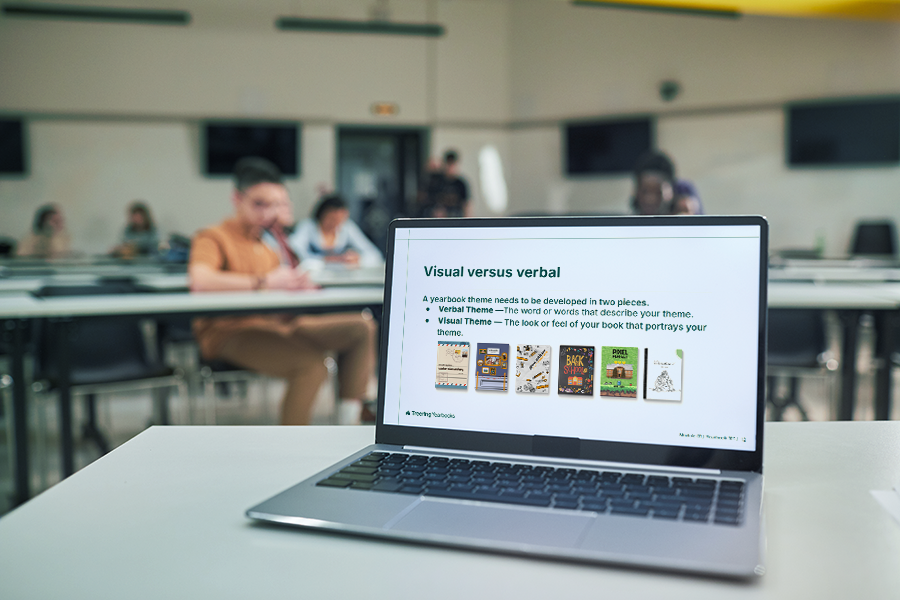
A yearbook curriculum you'll love teaching
New for the 2025-2026 school year, Treering’s free yearbook curriculum has expanded. From a new adviser handbook to 40 standalone lessons, you can take a recess from yearbook planning stress and put effort into yearbook production.
What’s new?
Teachers updated Treering’s previous curriculum. Another group of teachers tested it. We can confidently say it is teacher-authored and teacher-approved.
Each of the eight student-facing modules has a pacing guide and instructional slides. The pacing guides give you an overview of each module’s five grab-and-go lessons, including teaching resources, should you choose to expand instructional time. If it’s your first time teaching yearbook, the pacing guide also breaks down terminology used and shows connections between lessons.
Each lesson also includes Google Slides with
- Learning target
- Bell ringer
- Interactive lesson with guided student practice
- Exit ticket
You do enough. However, Treering knows no two schools/classes/clubs are alike, so we made our free curriculum 100% editable.
Curriculum FAQs
What’s free?
Everything. Charging extra for resources and support isn’t our thing.
How can I use the curriculum if I only have a club?
The first lesson in each module is a standalone one designed to give you the foundation for teambuilding, theme, design, writing, photography, marketing, and proofing. We recommend club groups do these eight lessons throughout the year.
Is Treering’s curriculum only for new yearbook students?
No, it is for yearbook creators of all backgrounds.
If you have mixed abilities in your class, we suggest:
- Using leaders to teach the first lesson in each module
- Flipping instruction: ask students to go through the slides on their own and be prepared to do the practice session in class
- Use mentor pairs for hands-on activities
Do I have to use Treering to use your yearbook curriculum?
Some theme, design, marketing, and editing lessons involve Treering tools.
Get Treering’s free yearbook curriculum

Module 0: Adviser Handbook
This handbook also contains all your yearbook prep templates: a student application, syllabus, grading rubrics, and staff manuals. It’s formatted vertically for printing.
Access the Adviser Handbook

Module 1: Yearbook 101
Building a yearbook culture on campus starts with your club or class. Each lesson in Module 1 focuses on team building, establishing clear expectations, and how students can use their individual strengths to build a unified product. This module builds a foundation for the following seven.
Module 1 learning targets:
- Understand the yearbook advisor’s expectations and the class structure
- Locate key information in the syllabus related to grading, expectations, deadlines, and responsibilities.
- Reflect on their personal strengths and interests related to team roles
- Identify and define core yearbook design terms by analyzing real spreads.
- Write specific, measurable, achievable, relevant, and time-bound (SMART) goals for the school year.
Access the Module 1 slides / Module 1 pacing guide
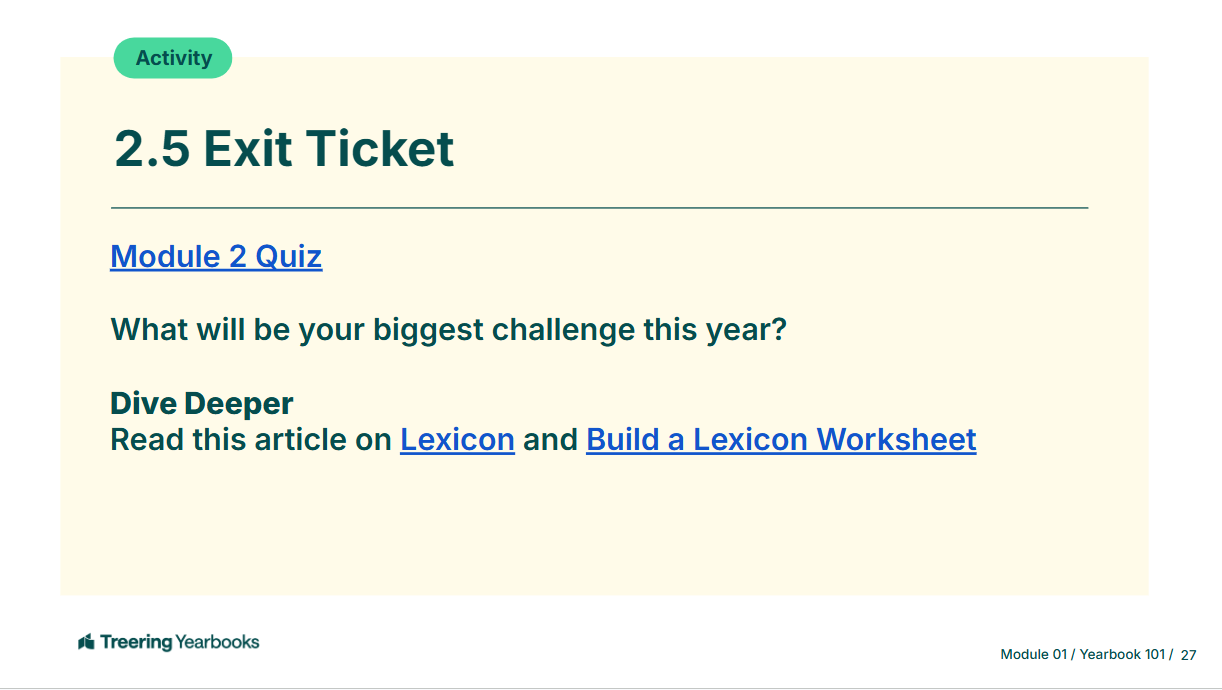
Module 2: Kicking off the Year(book)
Because yearbooks are part history book and part narrative, Module 2 helps students understand how and why the book they will create will stand the test of time. They will spend time creating a structure for their book and sharing their own stories through an “About Me” yearbook spread.
Module 2 learning targets
- Explain how yearbooks act as historical documents and cultural artifacts.
- Collaborate with peers to build a cohesive and well-organized ladder.
- Understand where and how to store content throughout the school year.
- Use yearbook vocabulary in context while giving and receiving peer feedback.
- Determine the central theme or message being communicated through advertisements.
Access the Module 2 slides / Module 2 pacing guide
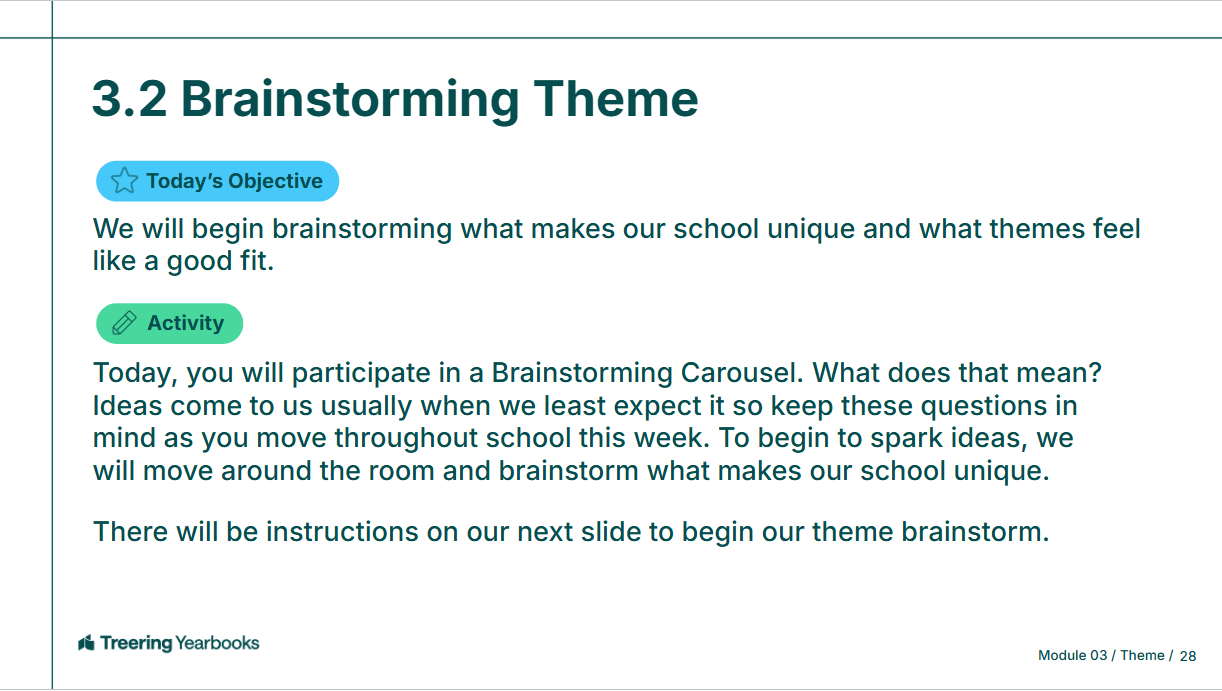
Module 3: Theme
Theme is more than just a visual concept, and Module 3 will help you and your yearbook team create one that looks, sounds, and feels like the story of their year.
Module 3 learning targets
- Understand the purpose and components of a yearbook theme.
- Collaboratively brainstorm relevant and original theme ideas.
- Connect theme ideas to the student body and school year.
- Explore the tone, personality, and voice of themes in a creative way.
- Create a plan to apply the theme across content areas.
Access the Module 3 slides / Module 3 pacing guide
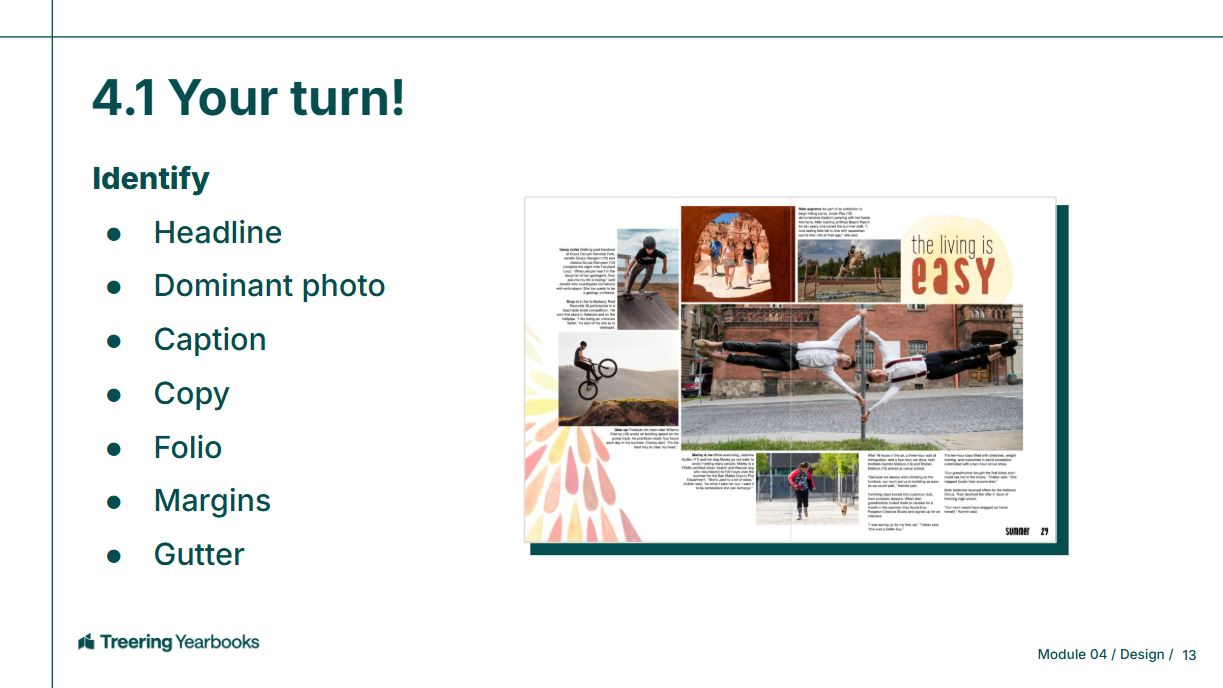
Module 4: Design
Building upon the theme developed in Module 3, Module 4 is all about bringing that theme to life and learning how to design yearbook pages that guide the reader on a visual journey. Intentional design is the core of this module.
Module 4 learning targets
- Identify the building blocks of design.
- Use Treering’s design tools to create a yearbook spread.
- Create a color palette to express the yearbook theme’s tone and personality.
- Explain the impact of font family, size, weight, and contrast in yearbook design.
- Create text styles to support the visual theme.
- Identify and apply principles of design hierarchy by organizing visual elements (text, images, and white space) on a yearbook spread to guide the reader’s attention effectively and create visual flow.
Access the Module 4 slides / Module 4 pacing guide
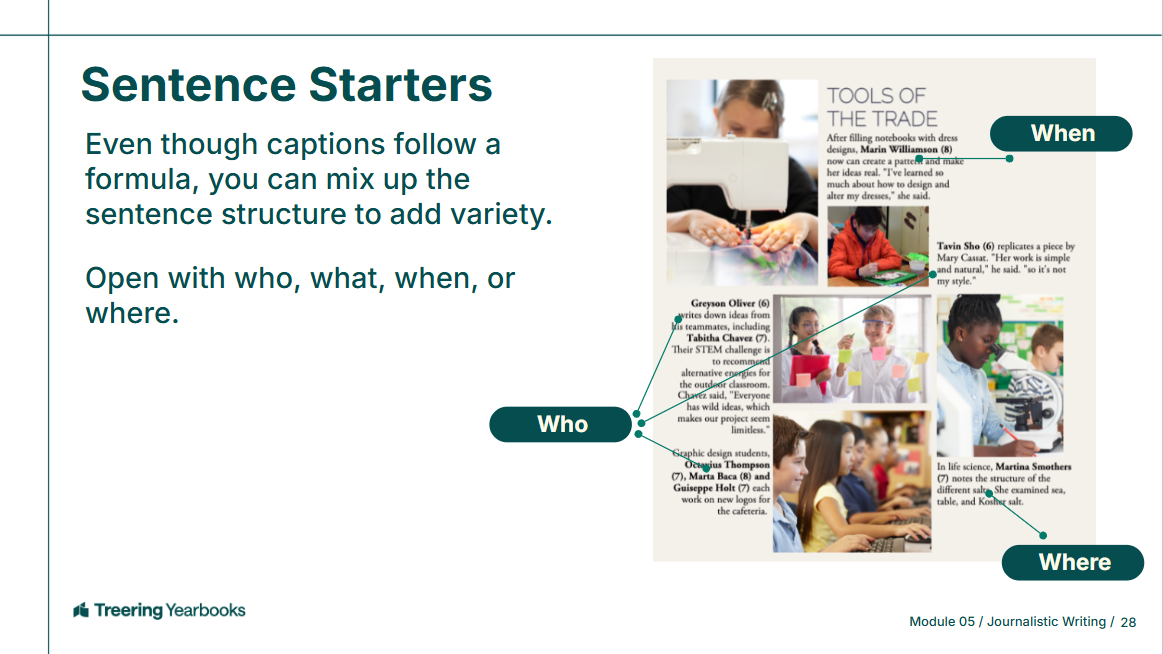
Module 5: Writing
Many times, students tell us they don’t want to add copy to the yearbook because “no one reads it.” Captions, stories, and pull quotes add to the visual story. These voices provide the context, insider information, and even names for your photos.
They are worthy of pursuit.
Module 5 learning targets:
- Identify the different forms of captions: ident, summary, and expanded.
- Examine photographs to identify key information to craft summary and expanded captions.
- Define the five common topics.
- Structure an interview.
- Synthesize and interview by writing body copy and captions.
Access the Module 5 slides / Module 5 pacing guide
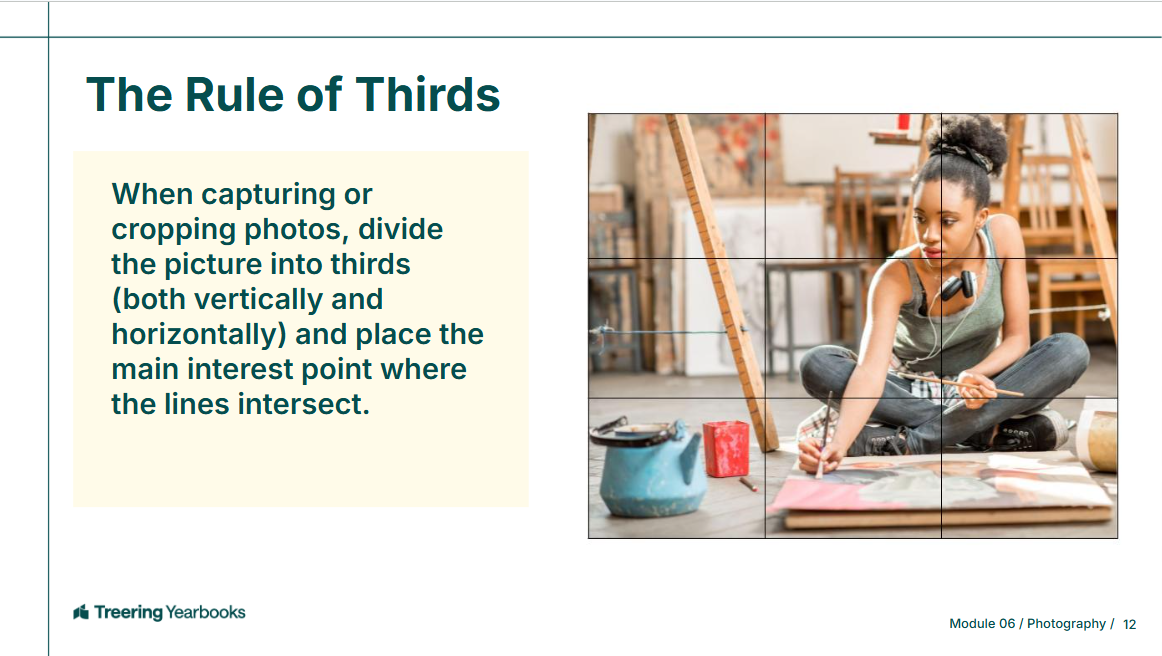
Module 6: Photography
Transform an ordinary photo into an extraordinary visual story through hands-on activities and real-world applications. With your class, explore how angles and lighting and exposure settings can drastically alter a photo’s impact on a yearbook spread.
Module 6 learning targets:
- Identify the composition elements of a photo and evaluate.
- Photograph a subject using six angles.
- Compose an image using natural and artificial light sources.
- Recall the three parts of the exposure triangle and how they work together.
- Use Treering tools to present a photograph to its advantage in a layout.
Access the Module 6 slides / Module 6 pacing guide
Module 7: Marketing - in development
Learning targets:
- Identify the components of a marketing campaign.
- Identify, classify, and rank yearbook value props.
- Differentiate marketing messaging based on audience.
- Initiate community participation in yearbook creation.
- Plan milestone celebrations for reaching yearbook creation goals.
Module 8: Proofing - in development
Learning targets:
- Discuss and develop a consistent framework for all copy elements and community-submitted content.
- Review editing guidelines to help catch errors and maintain consistency by reviewing content early and often.
- Identify tools and methods to carefully proof both visual and written elements for accuracy and clarity.
- Use checklists and tools to ensure every page aligns with your yearbook’s design standards.
- Learn to use Treering’s editing tools to establish and maintain clean lines and a polished, professional look.

New 2025 yearbook themes inspired by you
In the spring, nearly 200 yearbook creators across three focus groups gave their feedback on design trends and current graphic offerings. The findings:
- Backgrounds need to be less graphic and more textured to not compete with the content
- Theme collections felt incomplete
- Elementary yearbook coordinators want a different background for each grade
- Some schools want spreads with up to 60 photos, others want bold showstopper templates to break up content
- Preferred graphic styles include line art, watercolor, and images inspired by nature
Treering’s response: yes
It was a yes of agreement, a yes of exclamatory delight. When evaluating each of the 2025-2026 yearbook themes, the design team went back to your list.
The first six new yearbook themes
Each of the new yearbook themes contains what you need to easily create a beautiful, stylized, photo-centric yearbook: backgrounds, layouts, coordinating graphics, and a style guide. Layouts range from graphic-heavy show-stoppers to photo collages with up to 60 photos. The layouts are designed with a built-in 1/4" margin and a grid system. (This way you won’t have to hit the down arrow 100 times or “eyeball” it.)
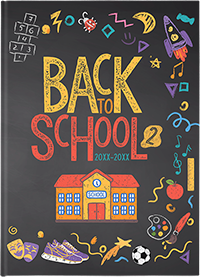
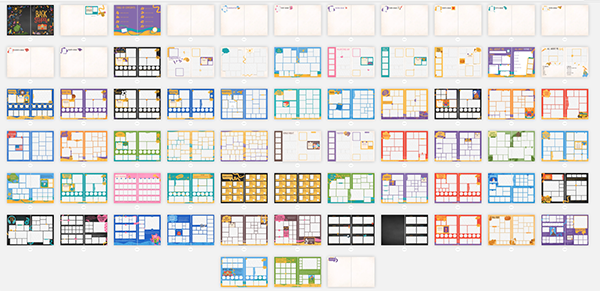
Back to School 2
Give your yearbook a sharp take on school spirit with just the right amount of whimsy. The hand-drawn chalk textures blend bright, bold hues with the nostalgic feel of a classic blackboard.
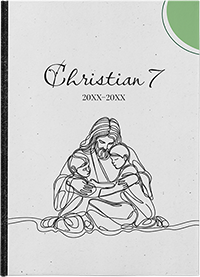
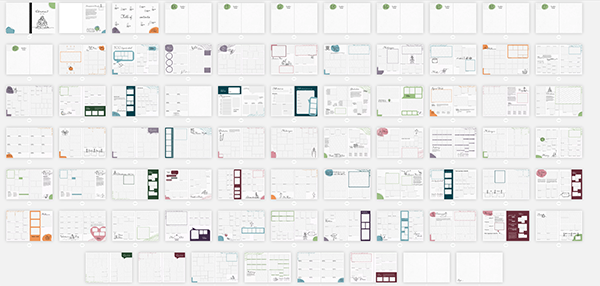
Christian7
Inspired by our third most popular theme, “Tied Together,” Christian7’s continuous line art contains graphics featuring faith-based and academic subjects.
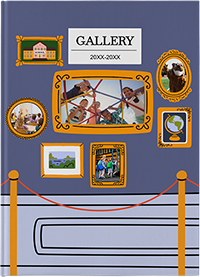

Gallery
This museum-inspired yearbook theme frames every moment as a masterpiece. It turns your year into a curated experience by showcasing every activity as worthy of display.

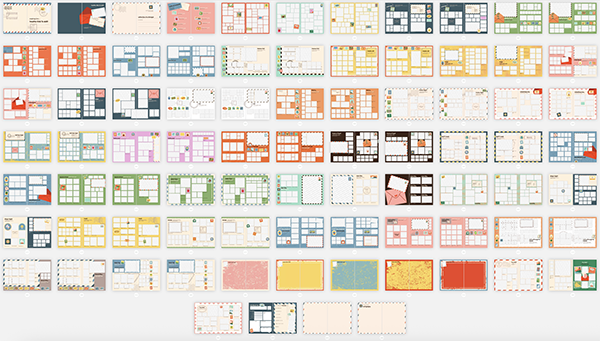
Greetings
We call the school year a journey, and with this yearbook theme, it truly is. The mid-century charm and travel-themed flair celebrate school life as a collection of picture-perfect stops.


Grow with Me
Designed with K-8 and K-12 schools in mind, “Grow with Me” has double the core graphics to show a progression from kindergarten through the upper grades. It grows from playful to polished with your students: think loose lines and wide rule transitioning to tight, precise graphics and graph paper. Pops of color vary from a waxy crayon to a layered highlighter.
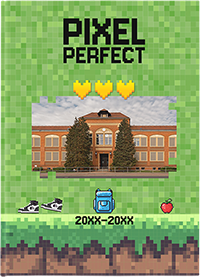
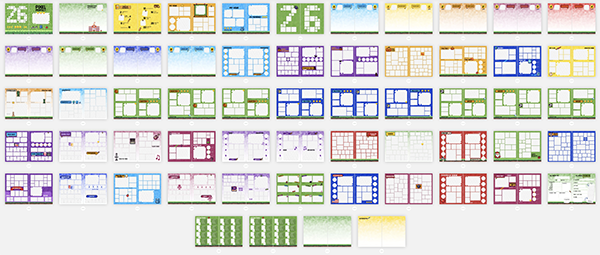
Pixel Perfect
Capture the energy of the school year with Pixel Perfect, a tech-inspired yearbook theme that is stacked with personality. It’s bold, playful, retro, and yet completely on trend.
View a slideshow of the 2025 yearbook themes.
The 100
While you love the theme development and the included graphics, you also asked for more “related” graphics to round out each theme. You wanted to illustrate the happenings on campus further. Again, the design team answered.
Introducing the 100, a curated collection of arts, academics, athletics, and event graphics from the top-searched images, illustrated with each theme’s personality.

Arts and academics: backpack, binder, books (stacked and open), bus, calculator, camera, chalkboard, chemistry flask, clipboards, clock, crayons, diploma, DNA strand, drum set, eraser, film reel, globe, glue stick, graduation cap, guitar, headphones, highlighter, laptop, lightbulb, lunchbox, magnifying glass, medal, microphone, microscope, monitor, music notes, notebook, paint palette, paintbrush, paperclip, pen, pencil, piano keys, red apple, ruler, school building, scissors, sharpener, speech bubble, stapler, test tube, theater masks, trophy, trumpet, and violin.
Athletics: badminton racket, badminton shuttlecock, baseball, baseball bat, baseball glove, basketball, bowling ball, bowling pins, boxing gloves, cheer megaphone, football, golf ball, golf club, hockey puck, hockey stick, ice skates, lacrosse stick, pom-poms, referee shirt, running shoes, sports jersey, soccer ball, softball, swim goggles, tennis ball, volleyball, water bottle, and whistle.
Events: bingo night, Christmas, color run, fall fun fest, father/daughter dance, field trip, graduation, Halloween, mother/son kickball, movie night, patriotic, read-a-thon, Red Ribbon Week, spring dance, spirit week, talent show, Thanksgiving, trunk or treat, Valentines, wax museum, and winter events.
Style guides for every new theme
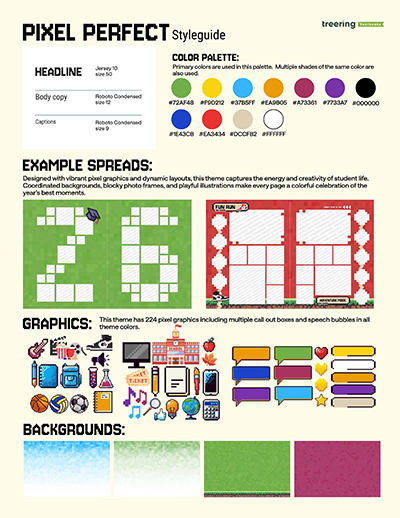
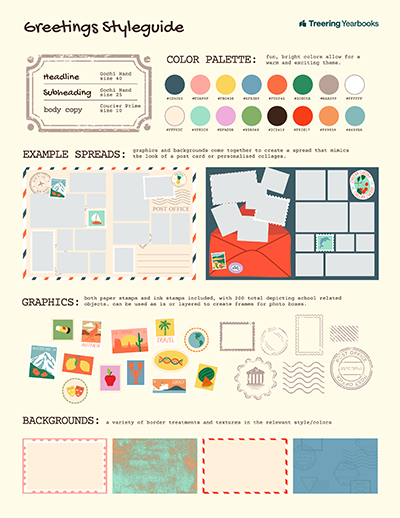
Perfect for emerging designers who use Treering themes as a launch pad to design their own layouts, these style guides contain
- Coordinating color palettes
- Headline, sub headline, and body copy font recommendations
- Ideas to make the graphics interact with photographs and text
Download the style guides for each theme here.
And if you noticed the bit about “part 1,” we hope you’re excited: there will be four more themes in September.

New school year, new us
We’ve got something exciting to share: Treering just got a bold new look.
After months of collaboration, exploration, and a lot of thoughtful design work, we’re thrilled to unveil a refreshed brand identity, one that better reflects who we are today and where we’re headed.
Turning the page
We’ve moved away from the softer, muted tones of the past and embraced a more vibrant, energetic palette that speaks to the creativity and joy at the heart of what we do.
Our new logo is a small thing that says a lot—it’s clean and modern, but it also holds meaning. The icon forms a “T” for Treering, doubles as an open book, and symbolizes our approachable, flexible platform. It’s our mission, captured in a single shape: helping people turn everyday moments into memories that last.
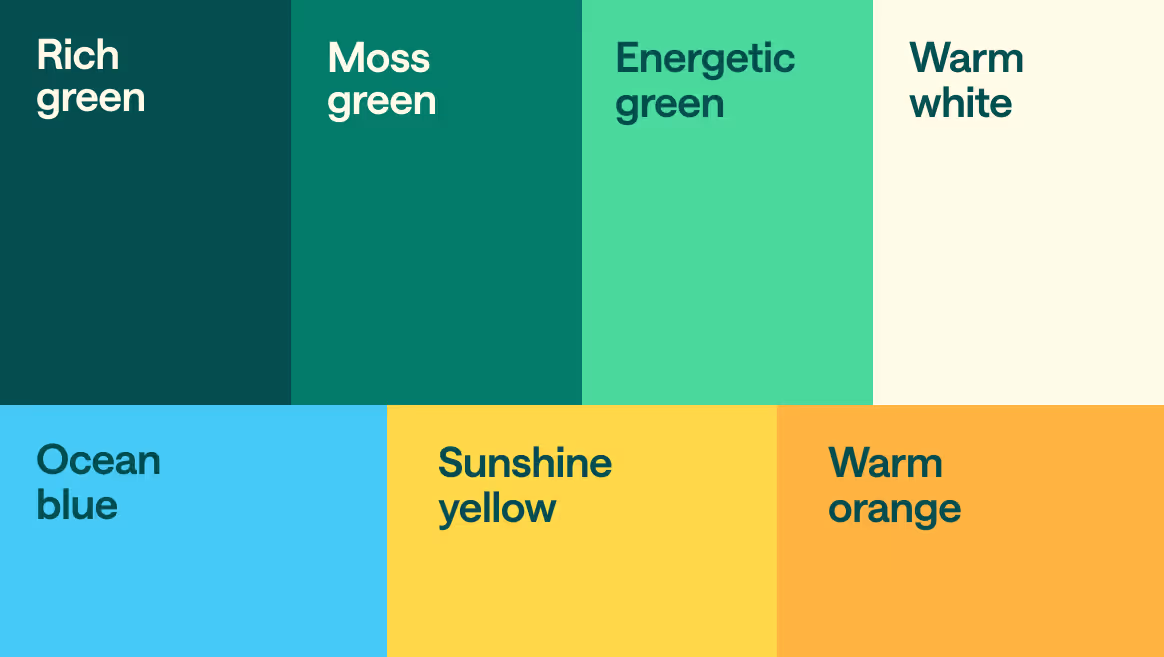
Why we did this
This wasn’t just about updating fonts and colors. We took a step back to reflect on who we are as a team, what makes Treering unique, and how we want to show up — for schools, parents, and now, for travel brands through Treering Memories.
After 16 years of innovating how memories are captured, shared, and preserved in the school space, we’re expanding our vision. Treering is evolving into a full Memory-as-a-Service platform, extending our technology and expertise beyond yearbooks to meet the growing demand for smart, personalized memory solutions across industries. With Treering Memories, we’re bringing the same intuitive experience, powerful AI, and just-in-time printing to the travel world by helping brands turn unforgettable trips into meaningful, lasting keepsakes.
The new visual identity balances the warmth of nostalgia with a fresh, modern sensibility. Our photography style is more candid and vibrant, our typography is clean and bold, and everything is built to work seamlessly—whether in a yearbook or in a photo memory book from a travel adventure.
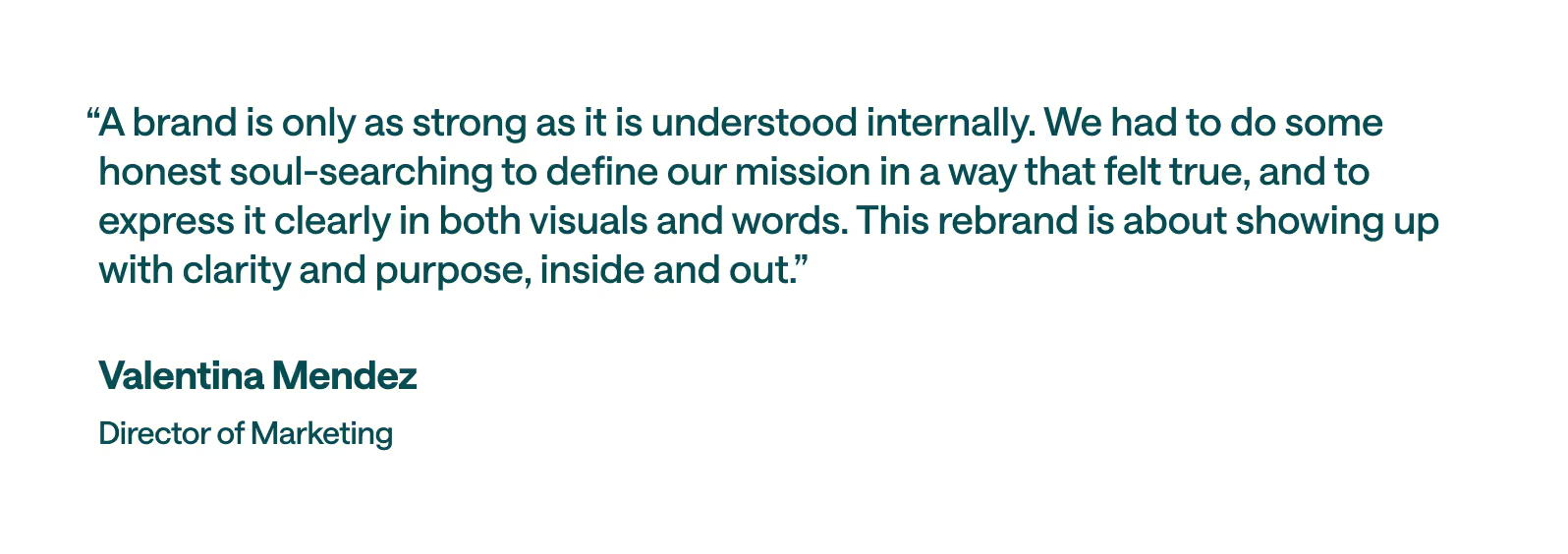
What’s next
We’re heading into the school year with renewed energy, and now a look that matches it. But while our visuals have changed, what we care about hasn’t. We’re still the same team, focused on helping people capture and celebrate meaningful moments with care, creativity, and technology that makes it all easier. This year, we’re rolling out smarter tools to simplify yearbook creation, along with fresh new themes designed to give schools even more ways to personalize and elevate their books. It's all part of our ongoing commitment to making yearbooking easier, more intuitive, and more inspiring for everyone involved. We can’t wait to show you what’s next. Let’s make this school year unforgettable, together.
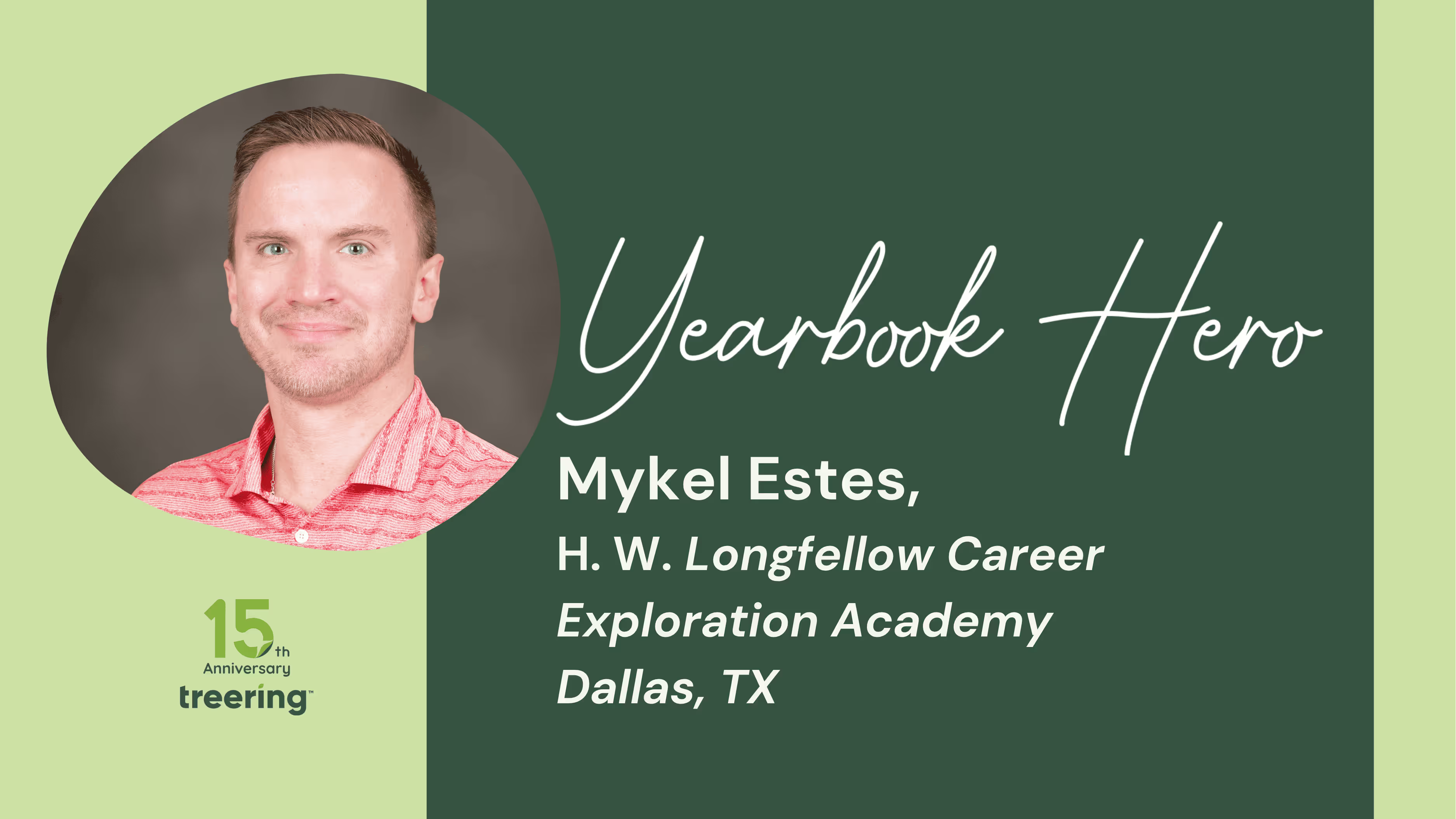
Yearbook Hero Mykel Estes modernizes memories
Treering Yearbook Heroes is a monthly feature focusing on yearbook tips and tricks.
For months, Mykel Estes was just a cool teacher we followed on X. Known in Dallas ISD for innovation and student engagement, the former Teacher of the Year (2023-2024) created a bracket so students could vote on their favorite yearbook theme. Estes revealed the theme at Longfellow Career Exploration Academy's first yearbook signing party in a decade.
Changing up how we do the yearbook this year at @LongfellowCEA —
— Mr. Mykel Estes, M.Ed. (@MrMykelEstes) August 20, 2024
Adding student voice is a critical goal! With @Treering's gallery of great themes we are incorporating a "Theme Thrown Down"!
Let's see what the winning concept will be! @disdactivities @DISDMagnets pic.twitter.com/0JMzz4jLVy
A reading and language arts teacher, Estes became the yearbook adviser after a staffing change. Instead of taking the proverbial reins, he rewrote the book.
How was your first yearbook a reboot for the school?
There are some things that they've always done, and this is a new iteration of the yearbook. We switched to Treering and even changed photography teams. Everything was new. And since I did take it on solo, I needed that. I needed that ability to streamline.
The previous books felt like a faculty and staff heirloom, when really, this is for students.
How do you keep the yearbook student-centric when you’re a solo adviser?
I started with a bunch of y'all's resources: the ladder, dos and don’ts, and Camp Yearbook. And I gave the sample package I received to the outgoing eighth-graders and told them, "Look through here."
It reminded me of those old school toy catalogs. They marked it up. I told them nothing was off the table.
Their suggestions became the collective basis for how I started the book. It was all over the place. The themes constantly changed, and that's when I had the “This isn't my yearbook” moment.
The March Madness-style "Theme Throwdown" bracket was how I ensured the theme would resonate with current students. What I like, and what older students liked, may not resonate with our current students. This was one way to get buy-in.
What happened when the students at Longfellow received the yearbook before school was out?
The yearbook's a really exciting kind of moment in a student's academic year, and from the pandemic on, the yearbook never arrived before the students left. There was a palpable disappointment in the students not being able to have that shared experience of looking for themselves in the yearbook and signing one another’s.
We do a big eighth-grade celebration week to commemorate the last time the cohort is together. (We feed into roughly 20 different high schools as a magnet school.) I really leaned into that nostalgia.
The eighth graders got them first. Again, leaning hard into that's their last time here. They get it first. Then we subsequently rolled it out to the lower grade levels.
What’s next for the yearbook?
We are a career academy. We have a journalism class coming up. We have a photojournalism class coming up. Those two classes will eventually marry in a year's time or so and be the production team for the yearbook.
Until then, I want to add student voices through quotes and make sure every kid is in the book. Every kid should at least be in the portraits. I want to expand that to a classroom and activity photo.
